Auditing Assignment: Carmine Enterprises - Professional Practice 1
VerifiedAdded on 2023/06/05
|11
|2481
|356
Report
AI Summary
This auditing assignment solution focuses on Carmine Enterprises, providing an audit planning report that highlights key accounts requiring assessment. It utilizes preliminary analytical procedures such as trend analysis and common size income statements to identify critical areas. The report details how to determine materiality using various percentages and emphasizes its importance in audit planning. Audit assertions and associated risks are outlined for each critical account, and a fraud risk analysis is conducted to examine potential fraudulent activities within the organization. The assignment includes a trial balance, quantitative estimates of materiality, income statement analysis, and suggested audit procedures for accounts like sales, cost of sales, repair and maintenance, and wages.
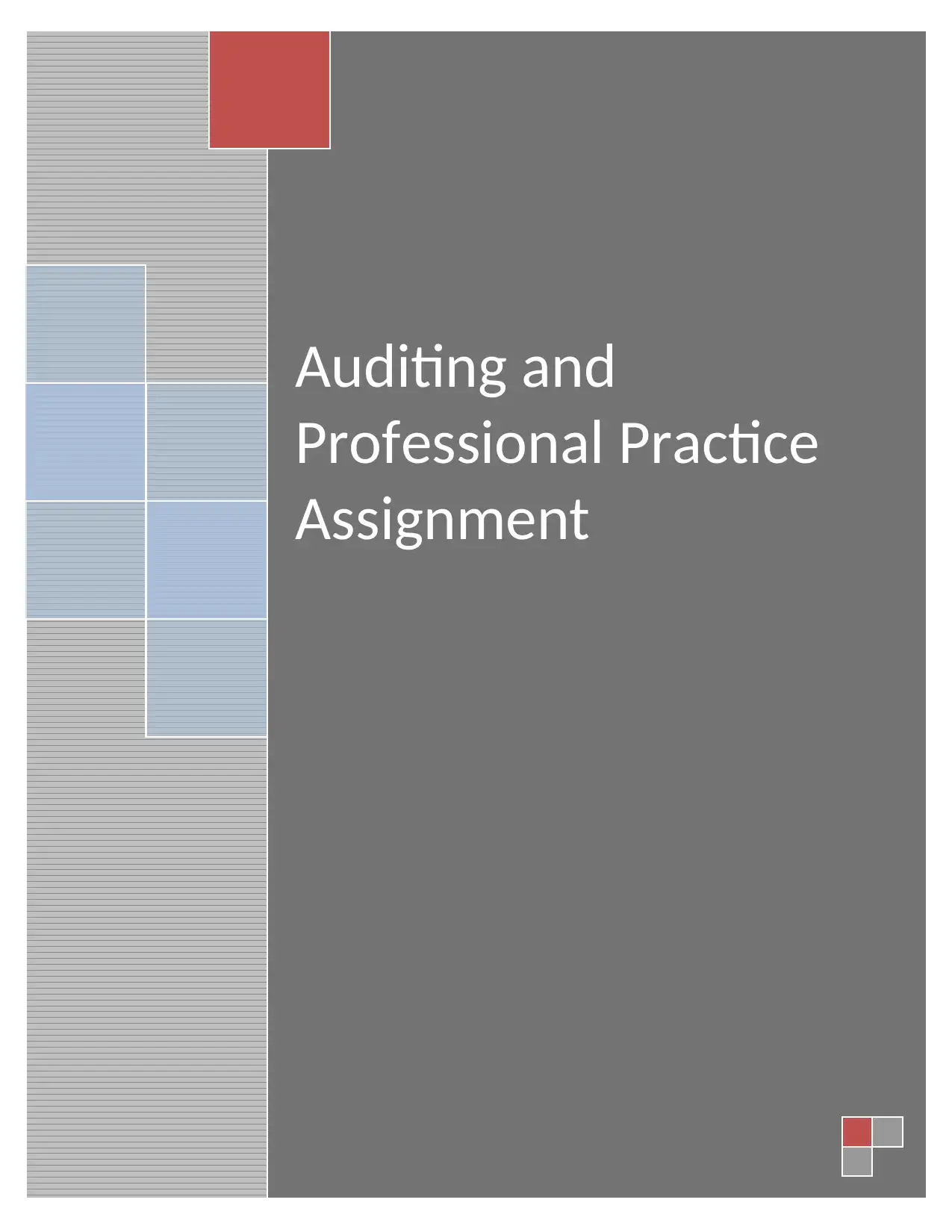
Auditing and
Professional Practice
Assignment
Professional Practice
Assignment
Paraphrase This Document
Need a fresh take? Get an instant paraphrase of this document with our AI Paraphraser

1
By student name
Professor
University
Date: 25 April 2018.
1 | P a g e
By student name
Professor
University
Date: 25 April 2018.
1 | P a g e
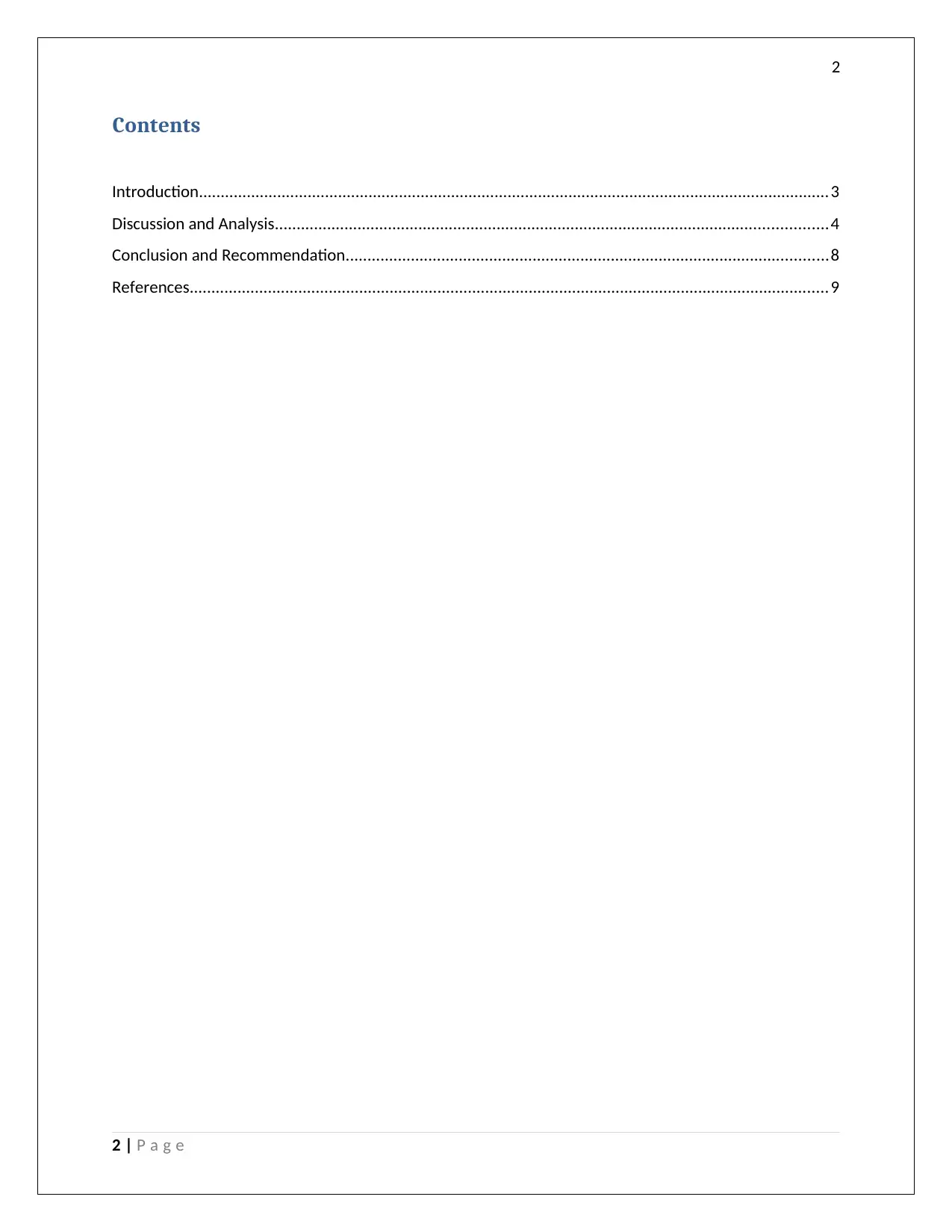
2
Contents
Introduction.................................................................................................................................................3
Discussion and Analysis...............................................................................................................................4
Conclusion and Recommendation...............................................................................................................8
References...................................................................................................................................................9
2 | P a g e
Contents
Introduction.................................................................................................................................................3
Discussion and Analysis...............................................................................................................................4
Conclusion and Recommendation...............................................................................................................8
References...................................................................................................................................................9
2 | P a g e
⊘ This is a preview!⊘
Do you want full access?
Subscribe today to unlock all pages.

Trusted by 1+ million students worldwide
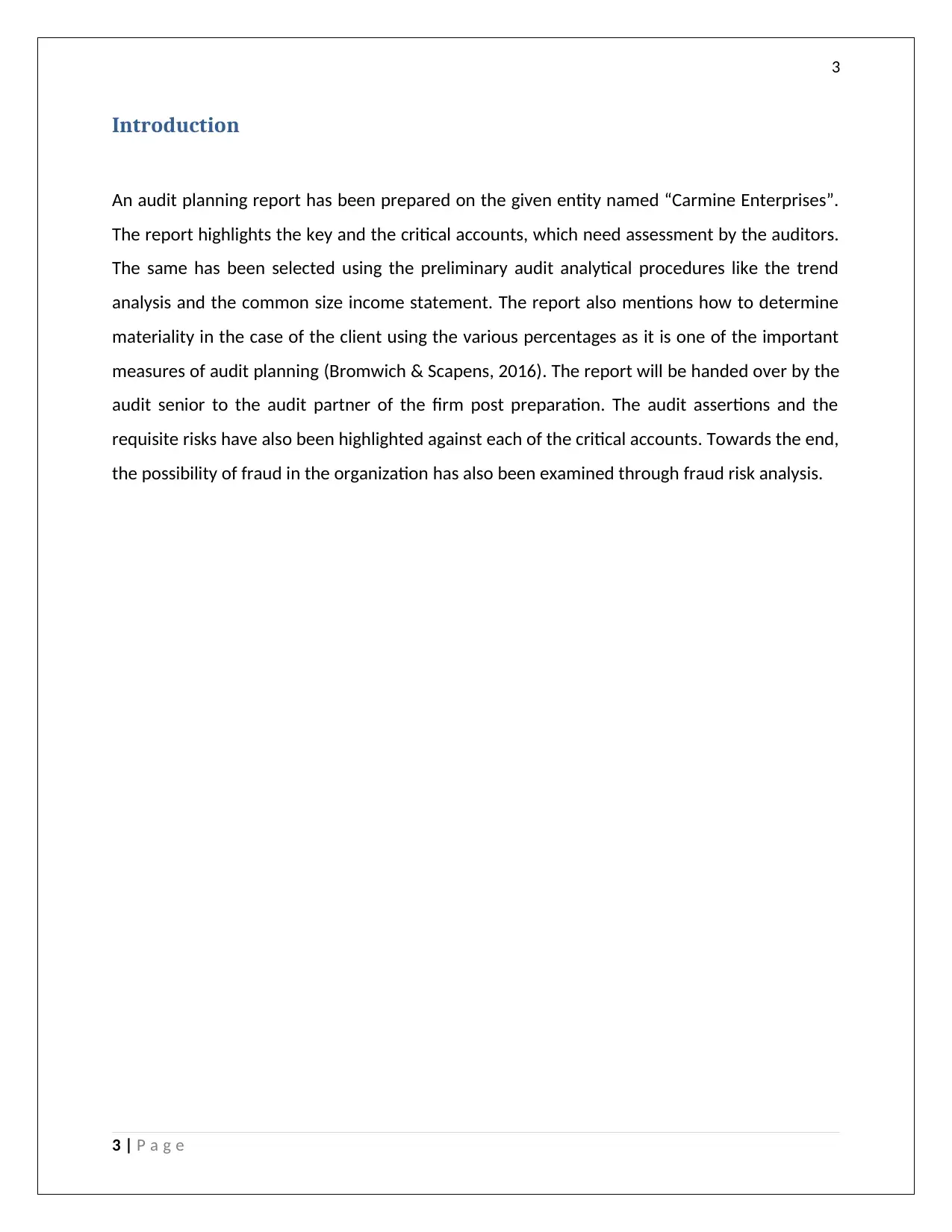
3
Introduction
An audit planning report has been prepared on the given entity named “Carmine Enterprises”.
The report highlights the key and the critical accounts, which need assessment by the auditors.
The same has been selected using the preliminary audit analytical procedures like the trend
analysis and the common size income statement. The report also mentions how to determine
materiality in the case of the client using the various percentages as it is one of the important
measures of audit planning (Bromwich & Scapens, 2016). The report will be handed over by the
audit senior to the audit partner of the firm post preparation. The audit assertions and the
requisite risks have also been highlighted against each of the critical accounts. Towards the end,
the possibility of fraud in the organization has also been examined through fraud risk analysis.
3 | P a g e
Introduction
An audit planning report has been prepared on the given entity named “Carmine Enterprises”.
The report highlights the key and the critical accounts, which need assessment by the auditors.
The same has been selected using the preliminary audit analytical procedures like the trend
analysis and the common size income statement. The report also mentions how to determine
materiality in the case of the client using the various percentages as it is one of the important
measures of audit planning (Bromwich & Scapens, 2016). The report will be handed over by the
audit senior to the audit partner of the firm post preparation. The audit assertions and the
requisite risks have also been highlighted against each of the critical accounts. Towards the end,
the possibility of fraud in the organization has also been examined through fraud risk analysis.
3 | P a g e
Paraphrase This Document
Need a fresh take? Get an instant paraphrase of this document with our AI Paraphraser

4
Discussion and Analysis
The trial balance of the given company “Carmine Enterprises” has been shown below and the
difference in between the debit and the credit side can be assumed the suspense account. This
amount has not been considered in any of the calculations as the nature of the same is not
known as to if it is asset or liability or expense or income, etc. (Choy, 2018).
Carmine Enterprises
Trial Balance
Particulars Jul 1, 16 - Mar 31, 17 Jul 1, 15 - June 30, 16
Debit Credit Debit Credit
Cash at Bank 85,000 80,000
Accounts receivable 118,340 111,000
Inventory 187,500 174,000
Machinery 71,000 65,000
Accumulated Depreciation 30,300 24,375
Motor Vehicles 66,000 66,000
Accumulated Depreciation 26,678 21,000
Furniture 7,400 7,400
Accumulated Depreciation 2,760 2,220
Bank Loan 230,000 230,000
Sales 141,750 187,450
Cost of sales 52,125 63,595
Consultancy fees 44,438 57,000
Interest income 36 50
Bank charges 261 350
Depreciation 12,143 15,863
Interest expense 8,625 11,500
Printing 189 250
Repairs and Maintenance 1,080 5,050
Wages 36,000 53,000
Superannuation 2,670 4,770
Total 648,333 475,962 657,778 522,095
4 | P a g e
Discussion and Analysis
The trial balance of the given company “Carmine Enterprises” has been shown below and the
difference in between the debit and the credit side can be assumed the suspense account. This
amount has not been considered in any of the calculations as the nature of the same is not
known as to if it is asset or liability or expense or income, etc. (Choy, 2018).
Carmine Enterprises
Trial Balance
Particulars Jul 1, 16 - Mar 31, 17 Jul 1, 15 - June 30, 16
Debit Credit Debit Credit
Cash at Bank 85,000 80,000
Accounts receivable 118,340 111,000
Inventory 187,500 174,000
Machinery 71,000 65,000
Accumulated Depreciation 30,300 24,375
Motor Vehicles 66,000 66,000
Accumulated Depreciation 26,678 21,000
Furniture 7,400 7,400
Accumulated Depreciation 2,760 2,220
Bank Loan 230,000 230,000
Sales 141,750 187,450
Cost of sales 52,125 63,595
Consultancy fees 44,438 57,000
Interest income 36 50
Bank charges 261 350
Depreciation 12,143 15,863
Interest expense 8,625 11,500
Printing 189 250
Repairs and Maintenance 1,080 5,050
Wages 36,000 53,000
Superannuation 2,670 4,770
Total 648,333 475,962 657,778 522,095
4 | P a g e
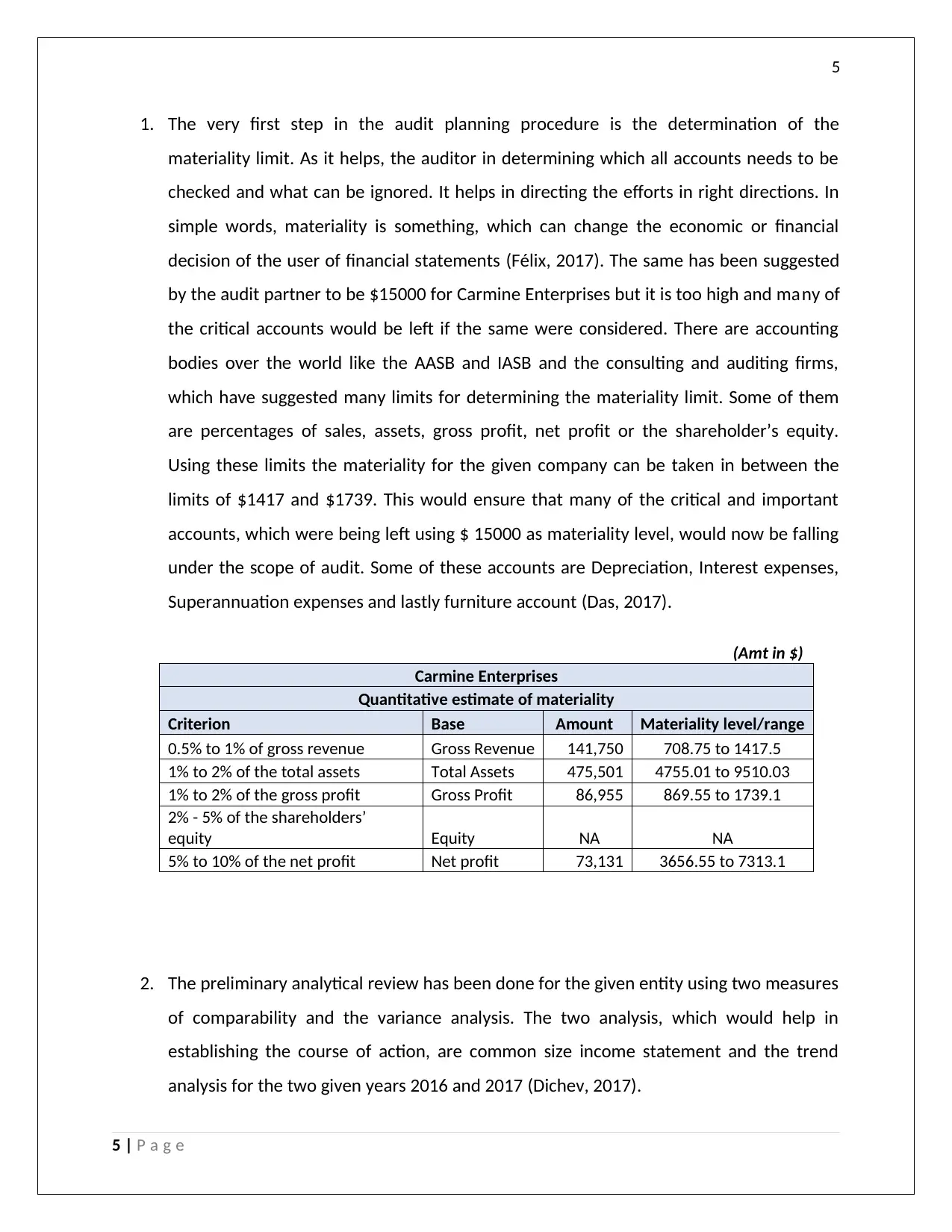
5
1. The very first step in the audit planning procedure is the determination of the
materiality limit. As it helps, the auditor in determining which all accounts needs to be
checked and what can be ignored. It helps in directing the efforts in right directions. In
simple words, materiality is something, which can change the economic or financial
decision of the user of financial statements (Félix, 2017). The same has been suggested
by the audit partner to be $15000 for Carmine Enterprises but it is too high and many of
the critical accounts would be left if the same were considered. There are accounting
bodies over the world like the AASB and IASB and the consulting and auditing firms,
which have suggested many limits for determining the materiality limit. Some of them
are percentages of sales, assets, gross profit, net profit or the shareholder’s equity.
Using these limits the materiality for the given company can be taken in between the
limits of $1417 and $1739. This would ensure that many of the critical and important
accounts, which were being left using $ 15000 as materiality level, would now be falling
under the scope of audit. Some of these accounts are Depreciation, Interest expenses,
Superannuation expenses and lastly furniture account (Das, 2017).
(Amt in $)
Carmine Enterprises
Quantitative estimate of materiality
Criterion Base Amount Materiality level/range
0.5% to 1% of gross revenue Gross Revenue 141,750 708.75 to 1417.5
1% to 2% of the total assets Total Assets 475,501 4755.01 to 9510.03
1% to 2% of the gross profit Gross Profit 86,955 869.55 to 1739.1
2% - 5% of the shareholders’
equity Equity NA NA
5% to 10% of the net profit Net profit 73,131 3656.55 to 7313.1
2. The preliminary analytical review has been done for the given entity using two measures
of comparability and the variance analysis. The two analysis, which would help in
establishing the course of action, are common size income statement and the trend
analysis for the two given years 2016 and 2017 (Dichev, 2017).
5 | P a g e
1. The very first step in the audit planning procedure is the determination of the
materiality limit. As it helps, the auditor in determining which all accounts needs to be
checked and what can be ignored. It helps in directing the efforts in right directions. In
simple words, materiality is something, which can change the economic or financial
decision of the user of financial statements (Félix, 2017). The same has been suggested
by the audit partner to be $15000 for Carmine Enterprises but it is too high and many of
the critical accounts would be left if the same were considered. There are accounting
bodies over the world like the AASB and IASB and the consulting and auditing firms,
which have suggested many limits for determining the materiality limit. Some of them
are percentages of sales, assets, gross profit, net profit or the shareholder’s equity.
Using these limits the materiality for the given company can be taken in between the
limits of $1417 and $1739. This would ensure that many of the critical and important
accounts, which were being left using $ 15000 as materiality level, would now be falling
under the scope of audit. Some of these accounts are Depreciation, Interest expenses,
Superannuation expenses and lastly furniture account (Das, 2017).
(Amt in $)
Carmine Enterprises
Quantitative estimate of materiality
Criterion Base Amount Materiality level/range
0.5% to 1% of gross revenue Gross Revenue 141,750 708.75 to 1417.5
1% to 2% of the total assets Total Assets 475,501 4755.01 to 9510.03
1% to 2% of the gross profit Gross Profit 86,955 869.55 to 1739.1
2% - 5% of the shareholders’
equity Equity NA NA
5% to 10% of the net profit Net profit 73,131 3656.55 to 7313.1
2. The preliminary analytical review has been done for the given entity using two measures
of comparability and the variance analysis. The two analysis, which would help in
establishing the course of action, are common size income statement and the trend
analysis for the two given years 2016 and 2017 (Dichev, 2017).
5 | P a g e
⊘ This is a preview!⊘
Do you want full access?
Subscribe today to unlock all pages.

Trusted by 1+ million students worldwide
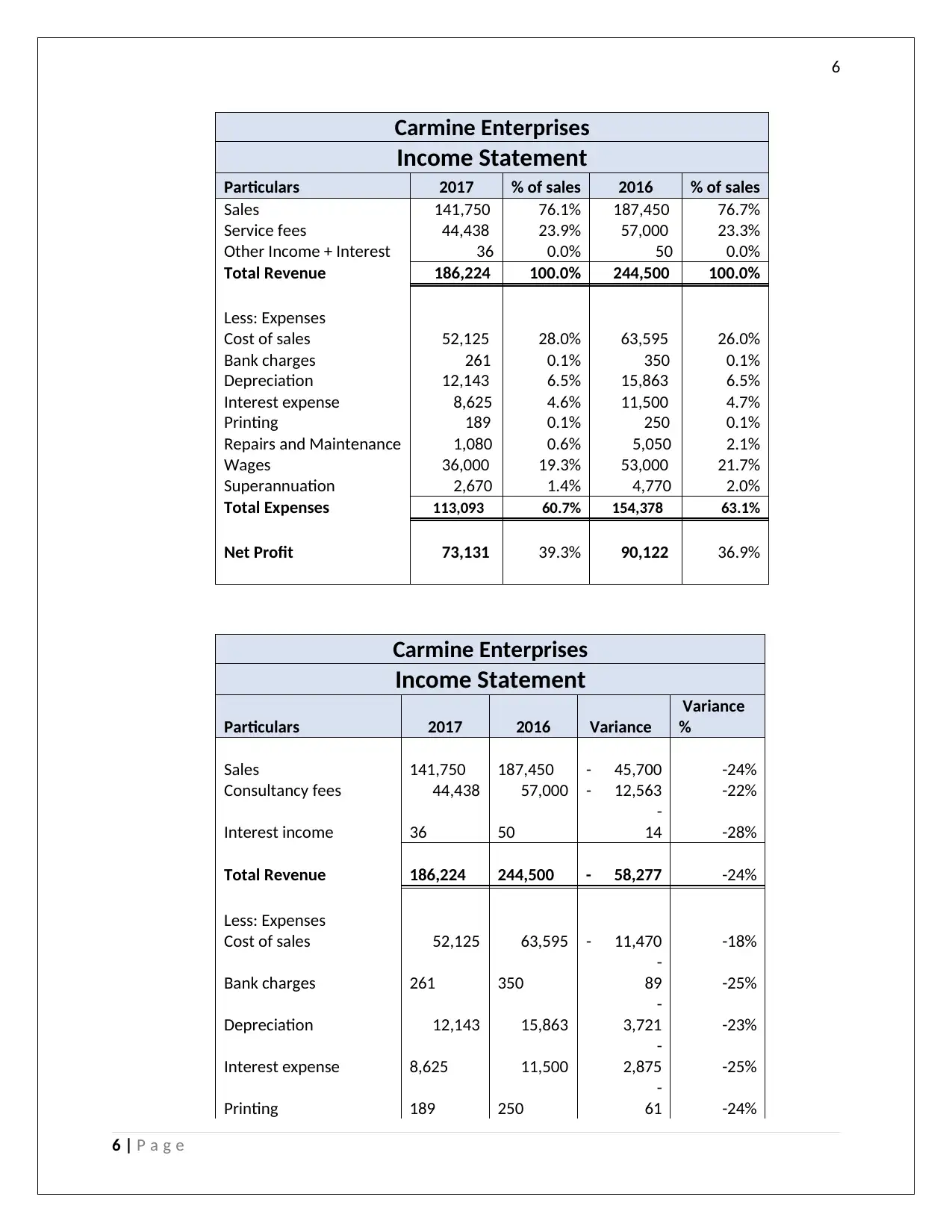
6
Carmine Enterprises
Income Statement
Particulars 2017 % of sales 2016 % of sales
Sales 141,750 76.1% 187,450 76.7%
Service fees 44,438 23.9% 57,000 23.3%
Other Income + Interest 36 0.0% 50 0.0%
Total Revenue 186,224 100.0% 244,500 100.0%
Less: Expenses
Cost of sales 52,125 28.0% 63,595 26.0%
Bank charges 261 0.1% 350 0.1%
Depreciation 12,143 6.5% 15,863 6.5%
Interest expense 8,625 4.6% 11,500 4.7%
Printing 189 0.1% 250 0.1%
Repairs and Maintenance 1,080 0.6% 5,050 2.1%
Wages 36,000 19.3% 53,000 21.7%
Superannuation 2,670 1.4% 4,770 2.0%
Total Expenses 113,093 60.7% 154,378 63.1%
Net Profit 73,131 39.3% 90,122 36.9%
Carmine Enterprises
Income Statement
Particulars 2017 2016 Variance
Variance
%
Sales 141,750 187,450 - 45,700 -24%
Consultancy fees 44,438 57,000 - 12,563 -22%
Interest income 36 50
-
14 -28%
Total Revenue 186,224 244,500 - 58,277 -24%
Less: Expenses
Cost of sales 52,125 63,595 - 11,470 -18%
Bank charges 261 350
-
89 -25%
Depreciation 12,143 15,863
-
3,721 -23%
Interest expense 8,625 11,500
-
2,875 -25%
Printing 189 250
-
61 -24%
6 | P a g e
Carmine Enterprises
Income Statement
Particulars 2017 % of sales 2016 % of sales
Sales 141,750 76.1% 187,450 76.7%
Service fees 44,438 23.9% 57,000 23.3%
Other Income + Interest 36 0.0% 50 0.0%
Total Revenue 186,224 100.0% 244,500 100.0%
Less: Expenses
Cost of sales 52,125 28.0% 63,595 26.0%
Bank charges 261 0.1% 350 0.1%
Depreciation 12,143 6.5% 15,863 6.5%
Interest expense 8,625 4.6% 11,500 4.7%
Printing 189 0.1% 250 0.1%
Repairs and Maintenance 1,080 0.6% 5,050 2.1%
Wages 36,000 19.3% 53,000 21.7%
Superannuation 2,670 1.4% 4,770 2.0%
Total Expenses 113,093 60.7% 154,378 63.1%
Net Profit 73,131 39.3% 90,122 36.9%
Carmine Enterprises
Income Statement
Particulars 2017 2016 Variance
Variance
%
Sales 141,750 187,450 - 45,700 -24%
Consultancy fees 44,438 57,000 - 12,563 -22%
Interest income 36 50
-
14 -28%
Total Revenue 186,224 244,500 - 58,277 -24%
Less: Expenses
Cost of sales 52,125 63,595 - 11,470 -18%
Bank charges 261 350
-
89 -25%
Depreciation 12,143 15,863
-
3,721 -23%
Interest expense 8,625 11,500
-
2,875 -25%
Printing 189 250
-
61 -24%
6 | P a g e
Paraphrase This Document
Need a fresh take? Get an instant paraphrase of this document with our AI Paraphraser
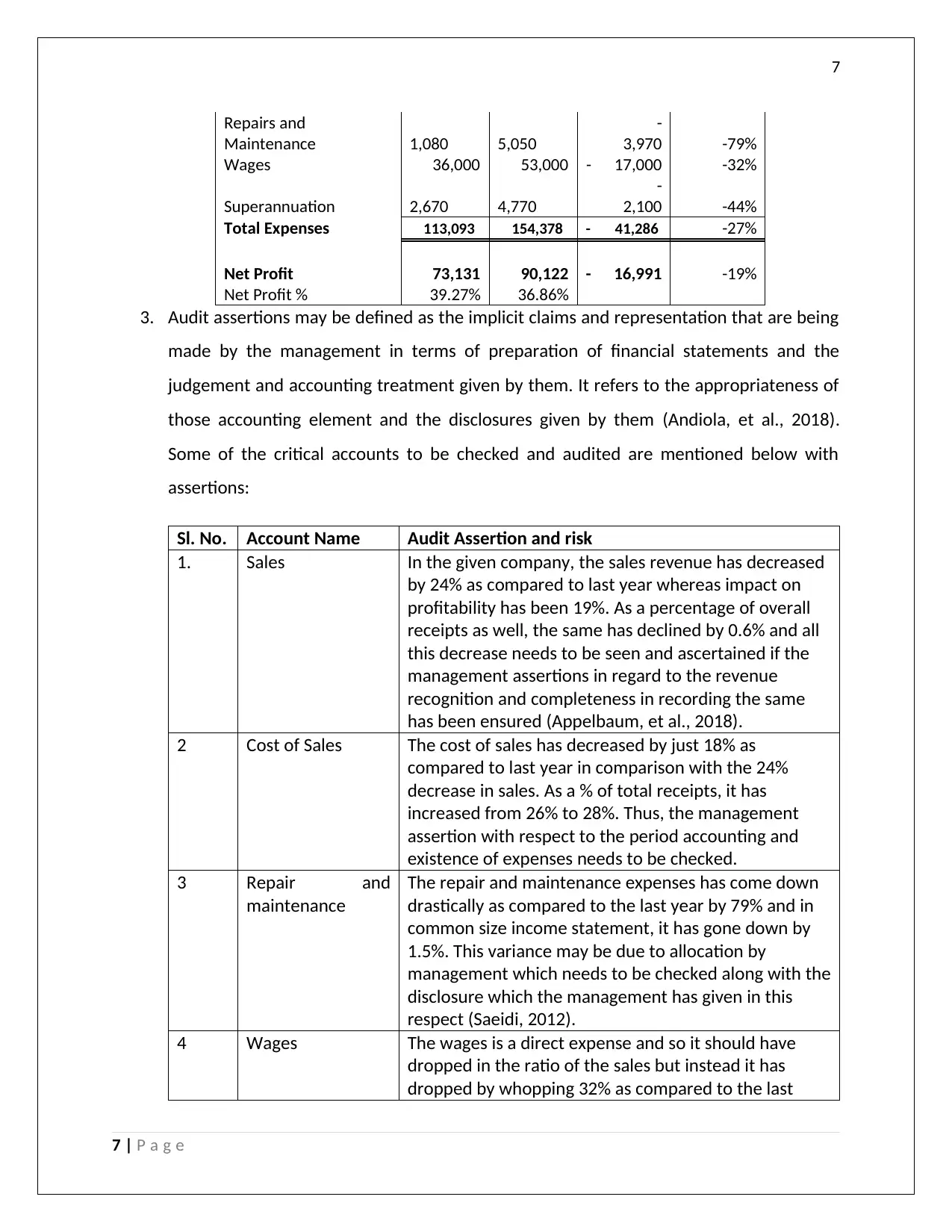
7
Repairs and
Maintenance 1,080 5,050
-
3,970 -79%
Wages 36,000 53,000 - 17,000 -32%
Superannuation 2,670 4,770
-
2,100 -44%
Total Expenses 113,093 154,378 - 41,286 -27%
Net Profit 73,131 90,122 - 16,991 -19%
Net Profit % 39.27% 36.86%
3. Audit assertions may be defined as the implicit claims and representation that are being
made by the management in terms of preparation of financial statements and the
judgement and accounting treatment given by them. It refers to the appropriateness of
those accounting element and the disclosures given by them (Andiola, et al., 2018).
Some of the critical accounts to be checked and audited are mentioned below with
assertions:
Sl. No. Account Name Audit Assertion and risk
1. Sales In the given company, the sales revenue has decreased
by 24% as compared to last year whereas impact on
profitability has been 19%. As a percentage of overall
receipts as well, the same has declined by 0.6% and all
this decrease needs to be seen and ascertained if the
management assertions in regard to the revenue
recognition and completeness in recording the same
has been ensured (Appelbaum, et al., 2018).
2 Cost of Sales The cost of sales has decreased by just 18% as
compared to last year in comparison with the 24%
decrease in sales. As a % of total receipts, it has
increased from 26% to 28%. Thus, the management
assertion with respect to the period accounting and
existence of expenses needs to be checked.
3 Repair and
maintenance
The repair and maintenance expenses has come down
drastically as compared to the last year by 79% and in
common size income statement, it has gone down by
1.5%. This variance may be due to allocation by
management which needs to be checked along with the
disclosure which the management has given in this
respect (Saeidi, 2012).
4 Wages The wages is a direct expense and so it should have
dropped in the ratio of the sales but instead it has
dropped by whopping 32% as compared to the last
7 | P a g e
Repairs and
Maintenance 1,080 5,050
-
3,970 -79%
Wages 36,000 53,000 - 17,000 -32%
Superannuation 2,670 4,770
-
2,100 -44%
Total Expenses 113,093 154,378 - 41,286 -27%
Net Profit 73,131 90,122 - 16,991 -19%
Net Profit % 39.27% 36.86%
3. Audit assertions may be defined as the implicit claims and representation that are being
made by the management in terms of preparation of financial statements and the
judgement and accounting treatment given by them. It refers to the appropriateness of
those accounting element and the disclosures given by them (Andiola, et al., 2018).
Some of the critical accounts to be checked and audited are mentioned below with
assertions:
Sl. No. Account Name Audit Assertion and risk
1. Sales In the given company, the sales revenue has decreased
by 24% as compared to last year whereas impact on
profitability has been 19%. As a percentage of overall
receipts as well, the same has declined by 0.6% and all
this decrease needs to be seen and ascertained if the
management assertions in regard to the revenue
recognition and completeness in recording the same
has been ensured (Appelbaum, et al., 2018).
2 Cost of Sales The cost of sales has decreased by just 18% as
compared to last year in comparison with the 24%
decrease in sales. As a % of total receipts, it has
increased from 26% to 28%. Thus, the management
assertion with respect to the period accounting and
existence of expenses needs to be checked.
3 Repair and
maintenance
The repair and maintenance expenses has come down
drastically as compared to the last year by 79% and in
common size income statement, it has gone down by
1.5%. This variance may be due to allocation by
management which needs to be checked along with the
disclosure which the management has given in this
respect (Saeidi, 2012).
4 Wages The wages is a direct expense and so it should have
dropped in the ratio of the sales but instead it has
dropped by whopping 32% as compared to the last
7 | P a g e

8
year. In terms of the common size income statement
again, it has dropped by more than 2.5% and thus it
needs to be checked if management has completely
recorded the expenses and considered appropriate
provision in the books (Solicitors, 2016).
4. Based on the above assertions, there are few audit procedures which have been
suggested for each of these accounts, the same has been mentioned below:
a. Sales: Vouching of the invoices must be done and the total of the sales invoices must
be cross verified with the sales ledger balance. In addition, the revenue recognition
policy of the company needs to be checked if the proper accounting rules are being
followed for revenue recognition and the adequate disclosures are being given in
regards to the same (Sirois, et al., 2018).
b. Cost of Sales: The cost of sales has increased comparatively in spite of the decrease
in sales and it needs to be checked though vouching of purchase invoices that
whether the raw material input prices have increased or is it due to decrease in
efficiency of operations. The auditor also needs to compare the market prices and
verify the purchase contracts to verify if the completeness in recording of
transactions are true value is being ensured (Erik & Jan, 2017).
c. Repair and Maintenance: The drastic decrease in repair expenses hint that either the
present year costs have been shifted to the next year or the last year expenses were
inflated. In both the cases, the auditor needs to check the supporting evidences of
repair and maintenance expenses and who has approved the same. The
management estimates and judgements in this regard also needs to be verified and
it needs to be checked if management is following accrual basis of accounting.
d. Wages: Finally, the wages being a direct expense is expected to decrease in
proportion of the sales but in the given case, since the same has fallen by 32%, the
auditors needs to check the labour register to ascertain if the no. of labourers
working have decreased or it is due to the decrease in the wages per head. The
statutory rule of minimum wages act needs to be followed by the company
(Lessambo, 2018).
8 | P a g e
year. In terms of the common size income statement
again, it has dropped by more than 2.5% and thus it
needs to be checked if management has completely
recorded the expenses and considered appropriate
provision in the books (Solicitors, 2016).
4. Based on the above assertions, there are few audit procedures which have been
suggested for each of these accounts, the same has been mentioned below:
a. Sales: Vouching of the invoices must be done and the total of the sales invoices must
be cross verified with the sales ledger balance. In addition, the revenue recognition
policy of the company needs to be checked if the proper accounting rules are being
followed for revenue recognition and the adequate disclosures are being given in
regards to the same (Sirois, et al., 2018).
b. Cost of Sales: The cost of sales has increased comparatively in spite of the decrease
in sales and it needs to be checked though vouching of purchase invoices that
whether the raw material input prices have increased or is it due to decrease in
efficiency of operations. The auditor also needs to compare the market prices and
verify the purchase contracts to verify if the completeness in recording of
transactions are true value is being ensured (Erik & Jan, 2017).
c. Repair and Maintenance: The drastic decrease in repair expenses hint that either the
present year costs have been shifted to the next year or the last year expenses were
inflated. In both the cases, the auditor needs to check the supporting evidences of
repair and maintenance expenses and who has approved the same. The
management estimates and judgements in this regard also needs to be verified and
it needs to be checked if management is following accrual basis of accounting.
d. Wages: Finally, the wages being a direct expense is expected to decrease in
proportion of the sales but in the given case, since the same has fallen by 32%, the
auditors needs to check the labour register to ascertain if the no. of labourers
working have decreased or it is due to the decrease in the wages per head. The
statutory rule of minimum wages act needs to be followed by the company
(Lessambo, 2018).
8 | P a g e
⊘ This is a preview!⊘
Do you want full access?
Subscribe today to unlock all pages.

Trusted by 1+ million students worldwide
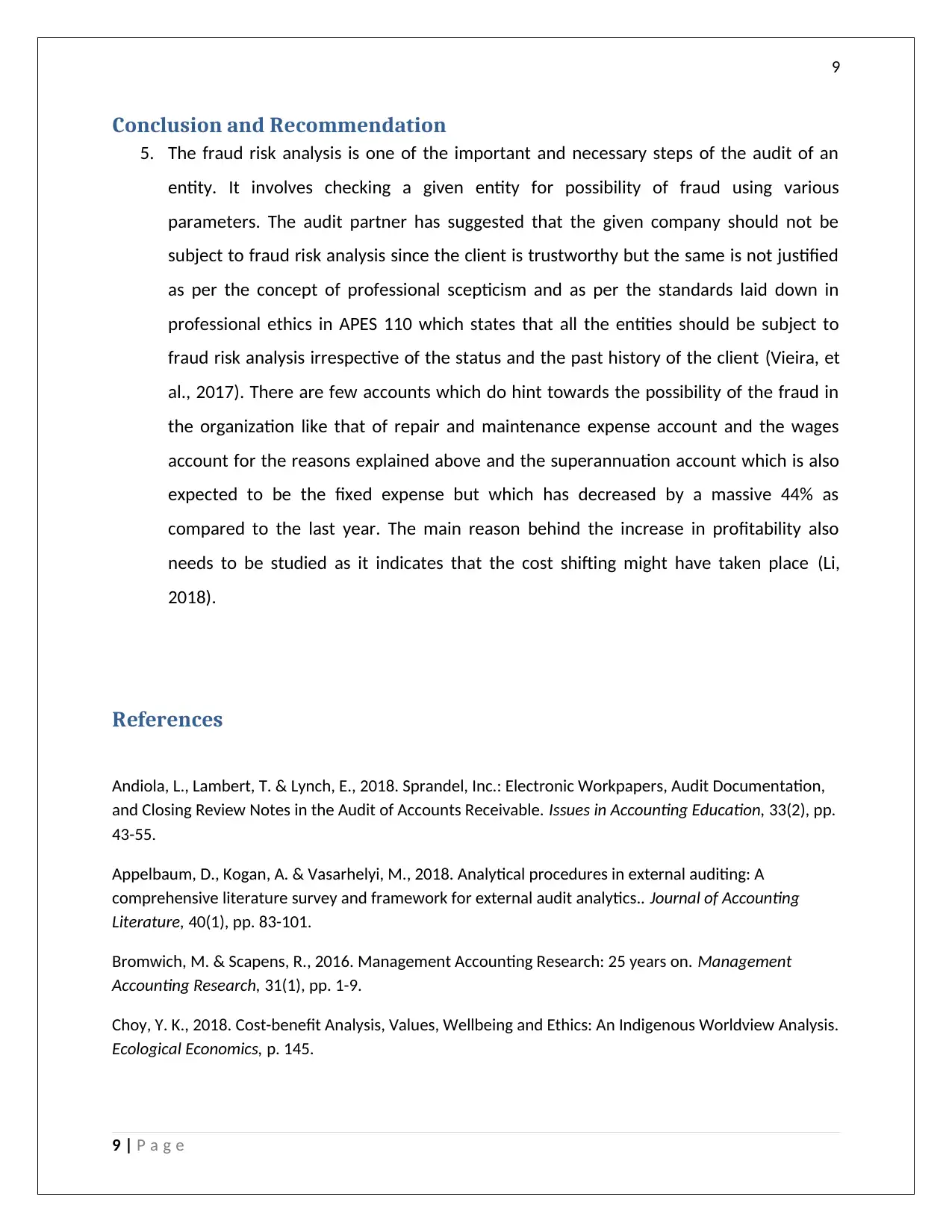
9
Conclusion and Recommendation
5. The fraud risk analysis is one of the important and necessary steps of the audit of an
entity. It involves checking a given entity for possibility of fraud using various
parameters. The audit partner has suggested that the given company should not be
subject to fraud risk analysis since the client is trustworthy but the same is not justified
as per the concept of professional scepticism and as per the standards laid down in
professional ethics in APES 110 which states that all the entities should be subject to
fraud risk analysis irrespective of the status and the past history of the client (Vieira, et
al., 2017). There are few accounts which do hint towards the possibility of the fraud in
the organization like that of repair and maintenance expense account and the wages
account for the reasons explained above and the superannuation account which is also
expected to be the fixed expense but which has decreased by a massive 44% as
compared to the last year. The main reason behind the increase in profitability also
needs to be studied as it indicates that the cost shifting might have taken place (Li,
2018).
References
Andiola, L., Lambert, T. & Lynch, E., 2018. Sprandel, Inc.: Electronic Workpapers, Audit Documentation,
and Closing Review Notes in the Audit of Accounts Receivable. Issues in Accounting Education, 33(2), pp.
43-55.
Appelbaum, D., Kogan, A. & Vasarhelyi, M., 2018. Analytical procedures in external auditing: A
comprehensive literature survey and framework for external audit analytics.. Journal of Accounting
Literature, 40(1), pp. 83-101.
Bromwich, M. & Scapens, R., 2016. Management Accounting Research: 25 years on. Management
Accounting Research, 31(1), pp. 1-9.
Choy, Y. K., 2018. Cost-benefit Analysis, Values, Wellbeing and Ethics: An Indigenous Worldview Analysis.
Ecological Economics, p. 145.
9 | P a g e
Conclusion and Recommendation
5. The fraud risk analysis is one of the important and necessary steps of the audit of an
entity. It involves checking a given entity for possibility of fraud using various
parameters. The audit partner has suggested that the given company should not be
subject to fraud risk analysis since the client is trustworthy but the same is not justified
as per the concept of professional scepticism and as per the standards laid down in
professional ethics in APES 110 which states that all the entities should be subject to
fraud risk analysis irrespective of the status and the past history of the client (Vieira, et
al., 2017). There are few accounts which do hint towards the possibility of the fraud in
the organization like that of repair and maintenance expense account and the wages
account for the reasons explained above and the superannuation account which is also
expected to be the fixed expense but which has decreased by a massive 44% as
compared to the last year. The main reason behind the increase in profitability also
needs to be studied as it indicates that the cost shifting might have taken place (Li,
2018).
References
Andiola, L., Lambert, T. & Lynch, E., 2018. Sprandel, Inc.: Electronic Workpapers, Audit Documentation,
and Closing Review Notes in the Audit of Accounts Receivable. Issues in Accounting Education, 33(2), pp.
43-55.
Appelbaum, D., Kogan, A. & Vasarhelyi, M., 2018. Analytical procedures in external auditing: A
comprehensive literature survey and framework for external audit analytics.. Journal of Accounting
Literature, 40(1), pp. 83-101.
Bromwich, M. & Scapens, R., 2016. Management Accounting Research: 25 years on. Management
Accounting Research, 31(1), pp. 1-9.
Choy, Y. K., 2018. Cost-benefit Analysis, Values, Wellbeing and Ethics: An Indigenous Worldview Analysis.
Ecological Economics, p. 145.
9 | P a g e
Paraphrase This Document
Need a fresh take? Get an instant paraphrase of this document with our AI Paraphraser
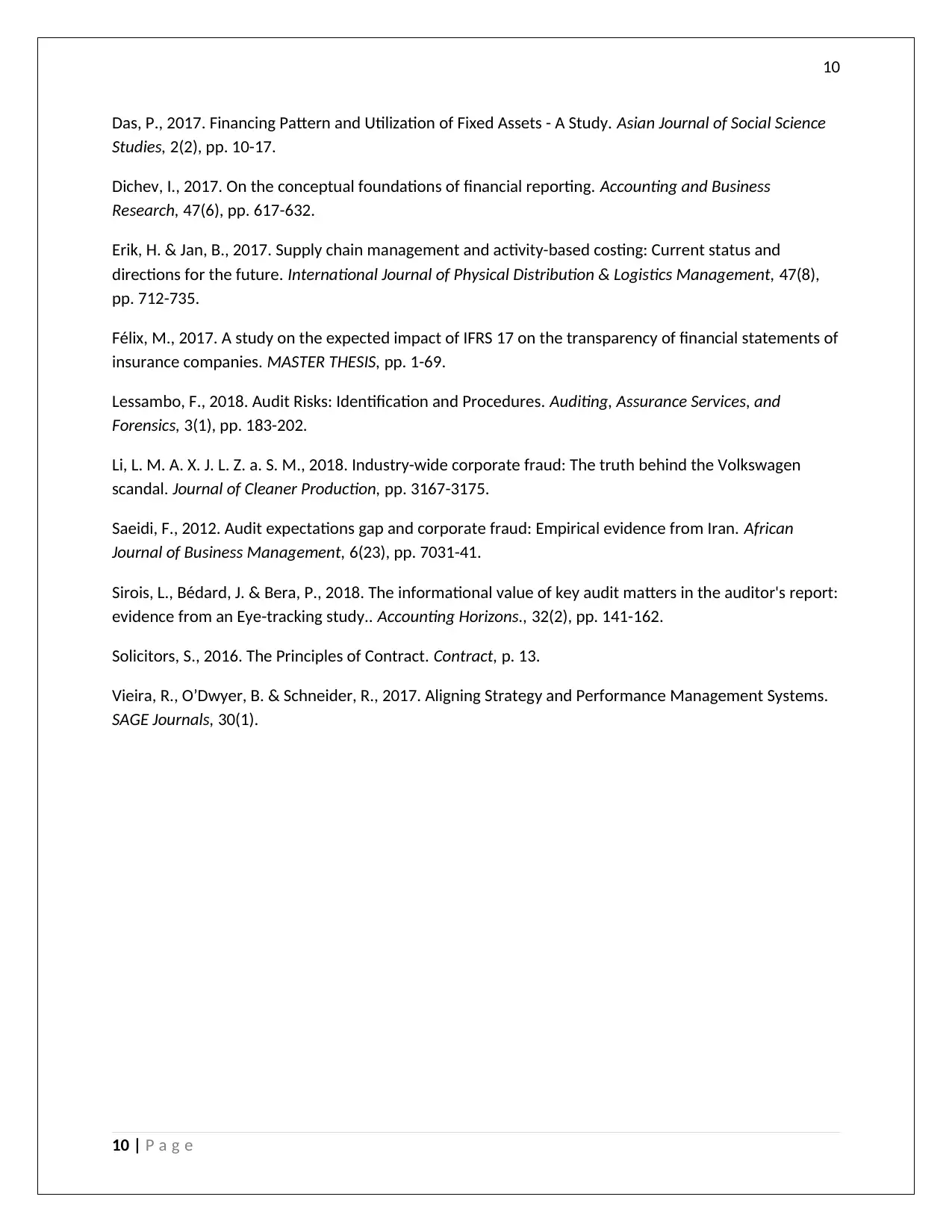
10
Das, P., 2017. Financing Pattern and Utilization of Fixed Assets - A Study. Asian Journal of Social Science
Studies, 2(2), pp. 10-17.
Dichev, I., 2017. On the conceptual foundations of financial reporting. Accounting and Business
Research, 47(6), pp. 617-632.
Erik, H. & Jan, B., 2017. Supply chain management and activity-based costing: Current status and
directions for the future. International Journal of Physical Distribution & Logistics Management, 47(8),
pp. 712-735.
Félix, M., 2017. A study on the expected impact of IFRS 17 on the transparency of financial statements of
insurance companies. MASTER THESIS, pp. 1-69.
Lessambo, F., 2018. Audit Risks: Identification and Procedures. Auditing, Assurance Services, and
Forensics, 3(1), pp. 183-202.
Li, L. M. A. X. J. L. Z. a. S. M., 2018. Industry-wide corporate fraud: The truth behind the Volkswagen
scandal. Journal of Cleaner Production, pp. 3167-3175.
Saeidi, F., 2012. Audit expectations gap and corporate fraud: Empirical evidence from Iran. African
Journal of Business Management, 6(23), pp. 7031-41.
Sirois, L., Bédard, J. & Bera, P., 2018. The informational value of key audit matters in the auditor's report:
evidence from an Eye-tracking study.. Accounting Horizons., 32(2), pp. 141-162.
Solicitors, S., 2016. The Principles of Contract. Contract, p. 13.
Vieira, R., O’Dwyer, B. & Schneider, R., 2017. Aligning Strategy and Performance Management Systems.
SAGE Journals, 30(1).
10 | P a g e
Das, P., 2017. Financing Pattern and Utilization of Fixed Assets - A Study. Asian Journal of Social Science
Studies, 2(2), pp. 10-17.
Dichev, I., 2017. On the conceptual foundations of financial reporting. Accounting and Business
Research, 47(6), pp. 617-632.
Erik, H. & Jan, B., 2017. Supply chain management and activity-based costing: Current status and
directions for the future. International Journal of Physical Distribution & Logistics Management, 47(8),
pp. 712-735.
Félix, M., 2017. A study on the expected impact of IFRS 17 on the transparency of financial statements of
insurance companies. MASTER THESIS, pp. 1-69.
Lessambo, F., 2018. Audit Risks: Identification and Procedures. Auditing, Assurance Services, and
Forensics, 3(1), pp. 183-202.
Li, L. M. A. X. J. L. Z. a. S. M., 2018. Industry-wide corporate fraud: The truth behind the Volkswagen
scandal. Journal of Cleaner Production, pp. 3167-3175.
Saeidi, F., 2012. Audit expectations gap and corporate fraud: Empirical evidence from Iran. African
Journal of Business Management, 6(23), pp. 7031-41.
Sirois, L., Bédard, J. & Bera, P., 2018. The informational value of key audit matters in the auditor's report:
evidence from an Eye-tracking study.. Accounting Horizons., 32(2), pp. 141-162.
Solicitors, S., 2016. The Principles of Contract. Contract, p. 13.
Vieira, R., O’Dwyer, B. & Schneider, R., 2017. Aligning Strategy and Performance Management Systems.
SAGE Journals, 30(1).
10 | P a g e
1 out of 11
Related Documents
Your All-in-One AI-Powered Toolkit for Academic Success.
+13062052269
info@desklib.com
Available 24*7 on WhatsApp / Email
![[object Object]](/_next/static/media/star-bottom.7253800d.svg)
Unlock your academic potential
Copyright © 2020–2025 A2Z Services. All Rights Reserved. Developed and managed by ZUCOL.




